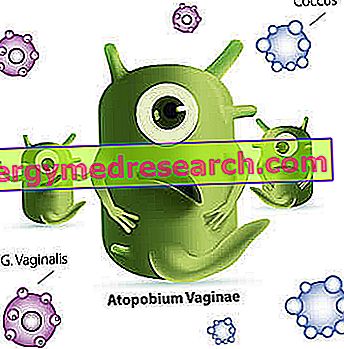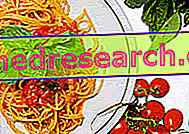Generality
The tomato puree is a fluid but dense compound, obtained by extracting the raw or cooked pulp from the whole fruit of the tomato plant.

The traditional procedure is simple:
- Remove the leaves and the stem from the fruits.
- Wash them.
- Wash them away.
- Grind them finely excluding the peel and seeds with the specific machine (electric, manual or with vegetables).
- Put in jars.
- Pasteurize / sterilize the jars in a large pot filled with boiling water.
See Alice's recipe: Tomato sauce "a Crudo".
Passata di Pomodoro - Canned Tomato "raw"
X Problems with video playback? Reload from YouTube Go to Video Page Go to Video Recipes Section Watch the video on youtubeSee also the variant: Passata di Pomodoti "a Cotto"
The wording "tomato sauce" does not necessarily indicate a preserved food and, if self-produced, it can also be used fresh.
The commercial tomato purée can be stored for a long time, thanks to the heat treatment to which it is previously subjected. Once the raw passata is obtained, it can be thickened by evaporating the water at a temperature of 65 ° C. It is then packaged and pasteurized (in glass or metal containers).
This system is "intermediate" between the "a cotto" and "raw" homemade production techniques.
In the Anglo-Saxon countries the tomato purée is known by the Italian name. On the contrary, it differs from the " tomato purée " which is obtained by higher cooking and very fine filtration, in order to obtain a denser product.
Other forms of preserved tomatoes are: peeled, pulp, pieces and concentrate (tomato paste).
Usually, " tomato sauce " means a denser, cooked and / or flavored recipe, therefore more elaborate (see below).
The tomato pulp has a medium-soft consistency; the taste is characteristic and the taste is quite sweet.
The tomato puree can be used to produce pasta dishes, main courses, soups, stews, sauces and any other recipe in which the tomato flavor is relevant.
The tomato contains a high percentage of water, which in the past corresponds to around 90% or slightly less (depending on the product). It has a moderate energy supply and provides significant quantities of certain salts and vitamins.
Nutritional Features
WARNING! The following comment refers to the nutritional content of commercial tomato puree. This contains three ingredients: tomato, salt (sodium chloride) and citric acid (acidity corrector).
Some chemical characteristics may not be verifiable in the table below.
Tomato sauce is a preparation made from tomatoes (VII fundamental group of foods), fruits that belong to the whole of vegetables.
These vegetables have a low energy supply, supplied mainly by carbohydrates. The protein and lipid content is negligible.
Carbohydrates are mainly simple and made of fructose; peptides have a low biological value and unsaturated fatty acids.
Tomato puree does not contain cholesterol; the fibers are present but lower than the whole tomato.
Regarding vitamins, tomato puree provides excellent levels of C (ascorbic acid) and pro vitamin A, in particular lycopene (a carotenoid famous for its antioxidant, anti-tumor and human metabolism characteristics). It is necessary to specify that vitamin C is thermolabile and easily oxidizable, which is why its content in the passata is lower than that of fresh raw tomatoes. The fresh tomato also contains folic acid, whose concentration is reduced in the past for the same reason as vitamin C.
As far as minerals are concerned, the passata contains good concentrations of potassium and sodium (the latter being higher than the fresh tomato due to the addition of salt necessary for storage).
Tomato purée is a food suitable for all diets. It has no contraindications for metabolic diseases and overweight. Some complain of a certain digestive difficulty, especially in the presence of gastric disorders such as hyperacidity, gastritis, hiatal hernia and / or gastroesophageal reflux disease; on the other hand, it is difficult to think that this could be a problem linked to the acidity of the food (the stomach is prone to tolerating a pH far lower than that of the tomato).
It does not contain lactose or gluten.
The past is tolerated by the vegetarian and vegan philosophy; with the guarantee that the processing temperature is equal to or less than 42 ° C, it is also suitable for raw food. For hygienic reasons, the commercial pasts do not respect this need.
In the macrobiotic diet, tomato purée is considered a product not recommended due to the lack of yin-yang balance (excess yin energy).
If properly certified, the tomato puree is suitable for Jewish and Muslim food; it has no contraindications even for Hinduism.
The average portion of tomato sauce varies according to the recipe in which it is used; 100g of purée (<20 kcal) is sufficient in a pasta dish (80 g raw weighted).
 | ||
| Edible part | 100.0% | |
| water | 90, 8g | |
| Protein | 1, 3g | |
| Prevailing amino acids | - | |
| Amino acid less present | - | |
| Lipids TOT | 0.2g | |
| Saturated fatty acids | -mg | |
| Monounsaturated fatty acids | -mg | |
| Polyunsaturated fatty acids | -mg | |
| Cholesterol | 0, 0mg | |
| TOT Carbohydrates | 3.0g | |
| Starch | 0.0g | |
| Soluble sugars | 3.0g | |
| Dietary fiber | -g | |
| Soluble fiber | -g | |
| Insoluble fiber | -g | |
| Power | 18, 0kcal | |
| Sodium | 160, 0mg | |
| Potassium | -mg | |
| Iron | -mg | |
| Football | 16, 0mg | |
| Phosphorus | 35, 0mg | |
| Zinc | -mg | |
| Thiamine | -mg | |
| Riboflavin | -mg | |
| Niacin | -mg | |
| pyridoxine | -mg | |
| folate | -μg | |
| Vitamin A | 530, 0μg | |
| C vitamin | 8, 0mg | |
| Vitamin E | -mg | |
Tomato sauce: Is it different?
The wording "tomato sauce" was used for the first time in the bibliography in the Italian cookery text "L'Apicio Moderno" written by the Roman chef Francesco Leonardi in 1790.
Tomato sauce (abroad known as "napolitan sauce") is a generic term that refers to different types of recipes containing usually COTTA tomato sauce. This can be enriched with various seasonings and flavors. In some parts of the world the word "tomato sauce" refers to a product similar to ketchup.
The tomato sauce enriched and corrected in taste is a real "tomato sauce".
By cooking in a pan, you can concentrate the tomato sauce as you wish (being careful not to burn it). The heat treatment makes it possible not to add thickening ingredients and facilitates storage.
Tomato sauce is used as an accompanying ingredient for some more structured preparations that include: appetizers, first courses, main courses, unique dishes, pizza, etc.
The tomato sauce is perfect with pasta, bread, potatoes, meat, fish, eggs, cheese and vegetables.
The most used condiments for tomato sauce are: extra virgin olive oil, salt, chilli, garlic, black pepper, onion, celery, carrots, onion, basil, oregano and other aromatic herbs.
Other ingredients that are particularly suited to accompany tomato sauce and typify some recipes are: capers, anchovies, black or green olives, and white wine. In fact, both tomato sauce and passata can be used as a base for other more complicated sauces: marinara, ragù or bolognese, puttanesca, zingara etc.



